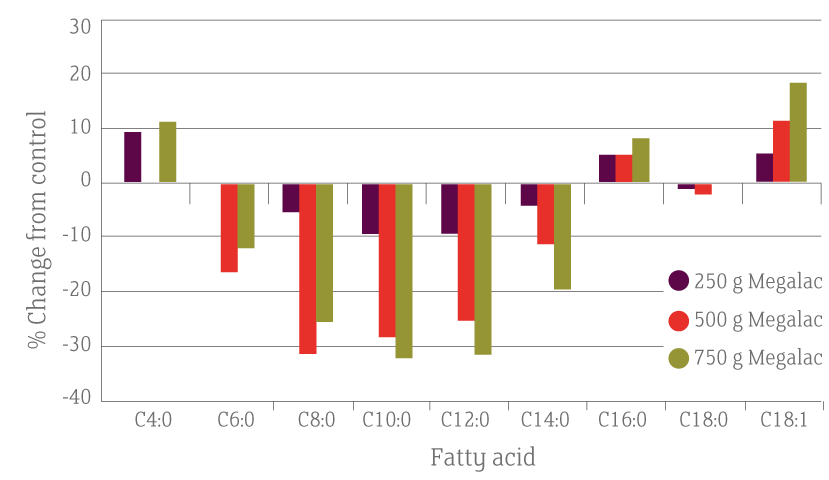Dietary fat effects on saturated fatty acids in milk
Up to 50% of the fatty acids in milk are derived directly from dietary sources. However, attempts to modify the fatty acid profile of ruminant milk fat by reducing the proportion of saturated fatty acids (SFA) and increasing the proportion of unsaturated fatty acids (USFA) represent a challenge to animal nutritionists. Unsaturated fatty acids entering the rumen are extensively (typically 85 to 97% of poly-unsaturated fatty acids) biohydrogenated to SFA such that regardless of the fatty acid profile of the diet consumed, the predominant fatty acids leaving the rumen for delivery to the mammary gland are saturated C16:0 and C18:0 with only a small proportion of USFA.
Due to the difficulty of delivering USFA post-rumen, considerable research effort has been directed to development of technologies which provide ‘protection’ of fatty acids from ruminal biohydrogenation. For example, almost half the fatty acids in Megalac are USFA in rumen-protected form and inclusion in rations can reduce the proportion of SFA in milk fat and increase the proportion of USFA, particularly C18:1 (Table 1) (Aikman et al., 2012; University of Reading, UK).
These data also highlight the effect on milk fatty acid profile of supplementing with a highly saturated fat supplement (approximately 85% C16:0 fatty acids). Supplementing with the high-C16 fat source increased concentration of C16 in milk, but did not increase the concentration of total SFA in milk due to a reduction in de novo-synthesized SFA.
Table 1 Fatty acid profile of milk from cows offered a 'high-C16' or Megalac supplement
| Fatty acid (% total fatty acids) | Treatment | Sig | ||
| Control | 'High-C16' | Megalac | ||
| C4:0 - C10:0 | 9.3a | 7.68b | 7.91b | ** |
| C12:0 - C14:0 | 17.5a | 13.6b | 14.2b | ** |
| C16:0 | 38.1b | 43.5a | 37.4b | ** |
| C18:1 cis-9 | 17.9b | 19.3b | 21.6a | ** |
| Total SFA | 75.3a | 73.8a | 70.9b | ** |
| Total cis-MUFA | 21.4b | 23.1b | 25.2a | ** |
** P<0.01 SFA, saturated fatty acids; MUFA, mono-unsaturated fatty acids.
Means within rows with different superscrips are significantly different (P<0.05)
A further study evaluated the effect of offering increasing levels of Megalac on milk fatty acid profile (Figure 1). Increasing Megalac from 250 through 500 and 750 g/d progressively reduced de novo-synthesised SFA, while increasing C18:1 USFA by up to 17% relative to the control diet (Palmquist et al., 1993).